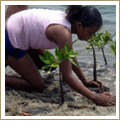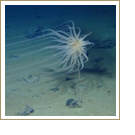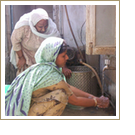|
|
 |
Subscribe to the Research Digest
or Read Online
|
|
|
|
|
|
Natural Solutions
It might be hard to believe that a pint-sized freshwater prawn could combat a deadly parasitic disease. But that's exactly what Woods Senior Fellow Giulio De Leo (Biology) and other researchers have found. Their recent study
tracks snails – carriers of schistosomiasis – and people in two West African villages. The abundance of infected snails and disease prevalence in a prawn-stocked village dropped
significantly compared to a village without prawns. The snail-eating prawns, which do not transmit the disease themselves, could provide disease control, biodiversity restoration, poverty
alleviation and improved nutrition. Through the Environmental Venture Projects seed grant program, Woods provided
crucial early support for the research project. It has since grown into the Upstream Alliance, and will soon have its own center on
disease, ecology, health and development at Stanford in collaboration with Woods and the Center for Innovation in Global Health.
Read more...
"Reduced Transmission of Human Schistosomiasis After Restoration of a Native Prawn That Preys on the Snail Intermediate Host," Proceedings of the National Academy of Sciences, July 20, 2015
Read on to explore other insights and discoveries on environmental challenges and solutions published by Stanford Woods Institute fellows and affiliated researchers.
|
|
|
|
|
|
|
 |
 |
Isolating the Underlying Causes of Extreme Weather
Worldwide news reports of extreme weather events – oppressive heat, parching droughts, destructive storms – are increasingly common. A study co-authored by Senior Fellow Noah Diffenbaugh (Earth System
Science) finds that trends in atmospheric circulation patterns can partially explain Earth's increasingly severe weather. While scientists had previously surmised that the link existed, robust empirical evidence was lacking.
Photo credit: NOAA
Read more...
"Contribution of Changes in Atmospheric Circulation Patterns to Extreme Temperature Trends," Nature, June 24, 2015
|
|
|
More information about Stanford Woods Institute climate research |
|
|
 |
 |
How Valuing Nature is Transforming Decisions
In the decade since publication of the landmark U.N. Millennium Ecosystem Assessment, scientists, policymakers, nonprofit organizations and corporations have worked together to incorporate the
value of nature in economic and social development plans. A series of papers highlights striking accomplishments of
these partnerships and shows how the science and practice of ecosystem services - the benefits nature provides - has matured. Many of the studies' authors work in collaboration with The Natural
Capital Project, a joint initiative of the Stanford Woods Institute and other organizations.
Photo credit: Nadia Bood / WWF
Read more...
"Nature as Capital," Proceedings of the National Academy of Sciences, June 16, 2015
|
|
|
Other Ecosystem Services and Conservation Research
"Nature Experience Reduces Rumination and Subgenual Prefrontal Cortex Activation," Proceedings of the National Academy of Science, June 29, 2015, co-authored by Senior Fellow Gretchen Daily (Biology)
"Accelerated Modern Human–Induced Species Losses: Entering the Sixth Mass Extinction," Science Advances, June 19, 2015, co-authored by Senior Fellow Paul Ehrlich (Biology)
"The Benefits of Nature Experience: Improved Affect and Cognition," Landscape and Urban Planning, June 2015, co-authored by Senior Fellow Gretchen Daily (Biology)
"Biodiversity in a Changing Climate: Linking Science and Management in Conservation," (book), University of California Press, June 2015, co-edited by Senior Fellow Terry Root (Biology)
"Collapse of the World's Largest Herbivores," Science Advances, May 1, 2015, co-authored by Senior Fellow Rodolfo Dirzo (Biology)
"A New Approach to Modeling the Sediment Retention Service (InVEST 3.0): Case study of the Cape Fear Catchment, North Carolina, USA," Science of The Total Environment. April 16, 2015, co-authored by Woods-affiliated postdoctoral scholar Perrine Hamel (Natural Capital Project) and Research Associate Becky Chaplin-Kramer (Natural Capital Project)
"A Secreted Effector Protein of Ustilago Maydis is Required to Guide Host Cells to Form Tumors in Maize Leaves," The Plant Cell, April 2015, co-authored by Woods-affiliated Professor of Biology Virginia Walbot
|
|
|
More information about Stanford Woods Institute ecosystem services research |
|
|
 |
 |
Marijuana's Environmental Impact
Recent debates about marijuana legalization have paid little attention to environmental issues. A paper co-authored by Senior Fellow Rosamond Naylor (Earth System Science) links marijuana cultivation to widespread environmental damage in California – the source of 60 to 70 percent of all marijuana consumed in the United States – and calls for greater regulation of the crop's impact on natural ecosystems.
Photo credit: Svetlana Nikolaeva
Read more...
"High Time for Conservation: Adding the Environment to the Debate on Marijuana Liberalization," BioScience, June 24, 2015
|
|
|
Other Food Security Research
"A Scalable Satellite-Based Crop Yield Mapper," Remote Sensing of Environment, July 2015, co-authored by William Wrigley Senior Fellow David Lobell (Earth System Science)
"Integrated Reactive Nitrogen Budgets and Future Trends in China," Proceedings of the National Academy of Science, June 29, 2015, co-authored by Senior Fellow Peter Vitousek (Biology)
"Greater Humification of Belowground Than Aboveground Biomass Carbon Into Particulate Soil Organic Matter in No-Till Corn and Soybean Crops," Soil Biology Biochemistry, June 2015, co-authored by Senior Fellow Robert Jackson (Earth System Science)
|
|
|
More information about Stanford Woods Institute food security research |
|
|
 |
 |
Toward Functional Water Law
Water law in the United States does little to encourage efficient, integrated management of different water sources. A book chapter co-authored by Rebecca Nelson, a non-resident fellow at Water in the West, and Senior Fellows Buzz Thompson (Law) and Richard Luthy (Civil and Environmental Engineering) examines ways for modern water law to aid conjunctive management of groundwater and surface water, and support interchange between urban and rural water supplies through water trading and the facilitation of agricultural use of urban wastewater.
Read more...
"Issues of Governance, Policy and Law in Managing Urban-Rural and Groundwater-Surface Water Connections," in Understanding and Managing Urban Water in Transition, 2015
|
|
|
Other Freshwater Research
"Electrical Resistivity Imaging of Seawater Intrusion into the Monterey Bay Aquifer System," Groundwater, June, 17, 2015, co-authored by Research Associate Tara Moran (Water in the West) and Senior Fellow Rosemary Knight (Geophysics)
"Recommendations on Model Criteria for Groundwater Sampling, Testing, and Monitoring of Oil and Gas Development in California" (REPORT), Lawrence Livermore National Laboratory, June 2015, co-authored by Senior Fellow Robert Jackson (Earth System Science)
"Declining Rainfall and Regional Variability Changes in Jordan," Water Resources Research, May 31, 2015, co-authored by Woods-affiliated postdoctoral scholar Kazi Rahman (Global Freshwater Initiative), Senior Fellow Steven Gorelick (Earth System Science), Woods-affiliated Ph.D. student Jim Yoon (Global Freshwater Initiative) and Woods-affiliated assistant professor of statistics and Earth system science Bala Rajaratnam
"Global Change and the Groundwater Management Challenge," Water Resources Research, May 3, 2015, co-authored by Senior Fellow Steven Gorelick (Earth System Science)
"A Review of the United States' Past and Projected Water Use," Journal of the American Water Resources Association, April 8, 2015, co-authored by Woods-affiliated postdoctoral scholar Debra Perrone (Water in the West)
"The Role of the Courts in Water Law," South Carolina Law Review, spring 2015, authored by Woods Co-Director and Senior Fellow Buzz Thompson (Law)
|
|
|
More information about Stanford Woods Institute freshwater research |
|
|
 |
 |
Protecting the Deep Sea
Thousands of feet below the ocean's surface lies a hidden world of undiscovered species and unique seabed habitats — as well as a vast untapped store of natural resources including valuable metals and rare-earth minerals. A paper co-authored by Senior Fellow Larry Crowder (Biology) proposes a strategy for balancing commercial extraction of deep-sea resources with protection of diverse seabed habitats. The paper is intended to inform upcoming discussions by the International Seabed Authority that will set the groundwork for future deep-sea environmental protection and mining regulations.
Photo credit: Craig Smith and Diva Amon, ABYSSLINE Project
Read more...
"Managing Mining of the Deep Seabed," Science, July 10, 2015
|
|
|
Other Oceans Research
"Productivity and Fishing Pressure Drive Variability in Fish Parasite Assemblages of the Line Islands, Equatorial Pacific," Ecology, May 2015, co-authored by Senior Fellow Fiorenza Micheli (Biology)
"Assessing Niche Width of Endothermic Fish from Genes to Ecosystem" Proceedings of the National Academy of Science, June 2015, co-authored by Senior Fellows Fiorenza Micheli (Biology) and Barbara Block (Biology)
"No-Take Marine Reserves Can Enhance Population Persistence and Support the Fishery of Abalone" Canadian Journal of Fisheries and Aquatic Sciences, June 3, 2015, co-authored by Senior Fellow Fiorenza Micheli (Biology)
"Ocean Acidification Science Needs for Natural Resource Managers of the North American West Coast," Oceanography, June 2015, co-authored by Senior Fellows Alexandria Boehm (Civil and Environmental Engineering) and Mark Jacobson (Civil and Environmental Engineering)
"A Global Viability Assessment of the European Eel," Global Change Biology, May 12, 2015, co-authored by Senior Fellow Giulio De Leo (Biology)
|
|
|
More information about Stanford Woods Institute oceans research |
|
|
 |
 |
Handwashing as Disease Fighter
Where diarrheal disease and acute respiratory infections are major causes of childhood death, rates of handwashing with soap tend to be low. To help design more effective interventions, a study co-authored by Senior Fellow Stephen Luby (Medicine) looked
at what handwashing agents people in rural Bangladesh use at specific times and why. To overcome obstacles to handwashing with soap, the researchers suggest reviewing current handwashing
promotional messages, and promoting handwashing with soapy water (detergent powder plus water), among other actions.
Read more...
"Observed Practices and Perceived Advantages of Different Hand Cleansing Agents in Rural Bangladesh: Ash, Soil and Soap," The American Journal of Tropical Medicine and Hygiene, April 13, 2015
|
|
|
More information about Stanford Woods Institute public health research |
|
|
 |
 |
U.S. Roadmap to 100-Percent Clean, Renewable Energy
One way to combat ongoing climate change, eliminate air pollution mortality, create jobs and stabilize energy prices involves converting the world's entire energy infrastructure to run on clean,
renewable energy. A study co-authored by Senior Fellow Mark Jacobson (Civil and Environmental Engineering) takes a step in that direction by outlining how each of the 50 American states could achieve such a transition by 2050.
The paper indicates that the conversion is technically and economically possible through the wide-scale implementation of existing technologies.
Photo credit: Vaclav Volrab / Shutterstock
Read more...
"100% Clean and Renewable Wind, Water and Sunlight (WWS) All-Sector Energy Roadmaps for the 50 United States," Energy and Environmental Sciences, May 27, 2015
|
|
|
Other Sustainable Development Research
"Cultivating Values: Environmental Values and Sense of Place as Correlates of Sustainable Agricultural Practices," Agriculture and Human Values, June 3, 2015, co-authored by Center Fellow Nicole Ardoin (Education)
"Ring of Impact from the Mega-Urbanization of Beijing between 2000 and 2009," Journal of Geophysical Research: Atmospheres, May 21, 2015, co-authored by Senior Fellow Mark Jacobson (Civil and Environmental Engineering)
"Using Online Narratives to Explore Participant Experiences in a Residential Environmental Education Program," Children's Geographies, April 22, 2015, co-authored by Center Fellow Nicole Ardoin (Education)
"Evaluation in Residential Environmental Education: An Applied Literature Review of Intermediary Outcomes," Applied Environmental Education & Communication, April 14, 2015, co-authored by Center Fellow Nicole Ardoin (Education)
|
|
|
More information about Stanford Woods Institute sustainable development research |
|
|
|
|
|
|
Find Us on the Web
    |
|
The Stanford Woods Institute Research Digest is a quarterly report of findings by Woods fellows and affiliated faculty, as well as fellows with the Institute's Leopold Leadership Program. Current and past issues are online.
Contact us to subscribe or provide information about new and forthcoming research.
To learn more about the Stanford Woods Institute for the Environment, visit our website or email us.
Stanford Woods Institute for the Environment
Jerry Yang & Akiko Yamazaki Environment & Energy Building - MC 4205
473 Via Ortega
Stanford, CA 94305
|
|
|
|
